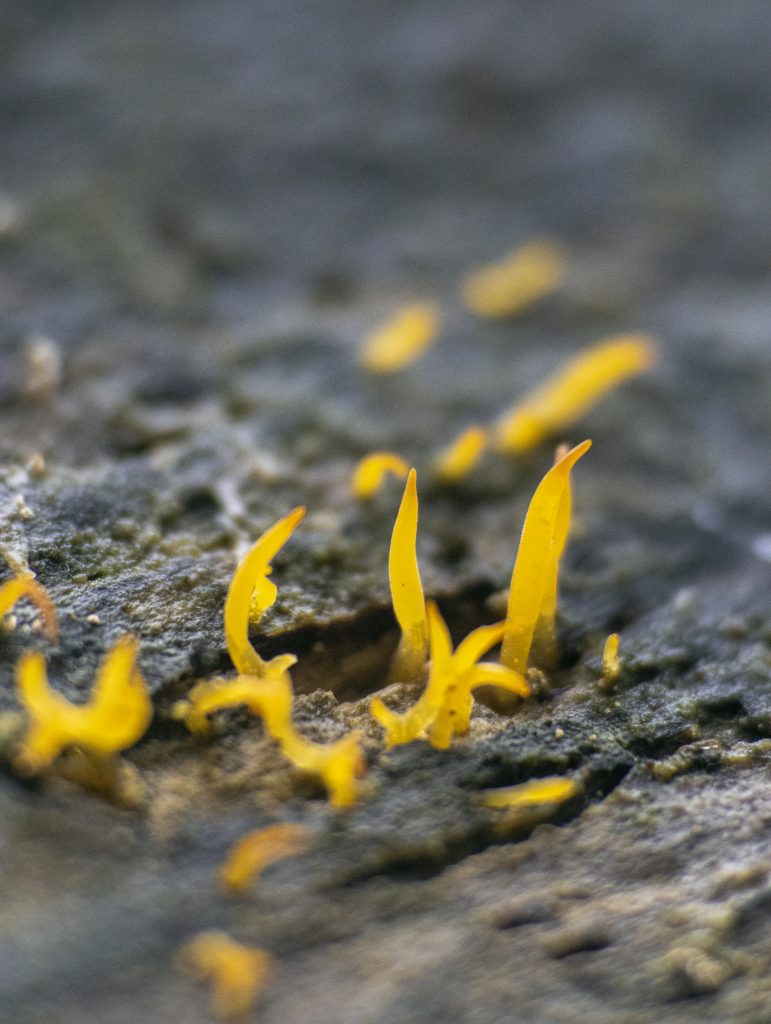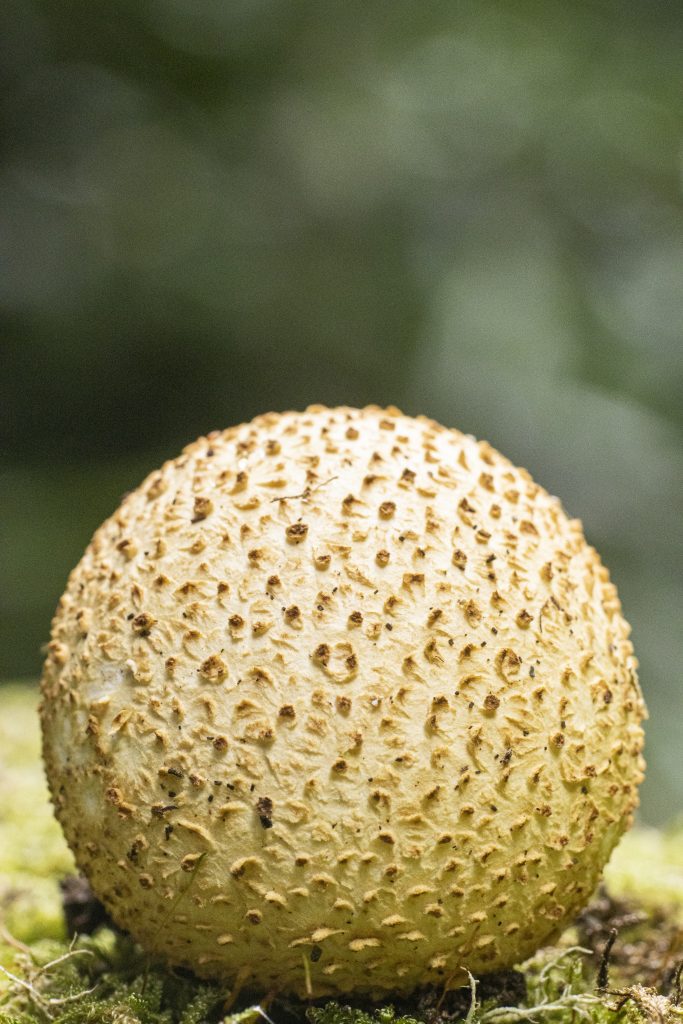Autumn Fungi
The period between late Summer and Autumn is the perfect time for all kinds of fungi to grow! The warm weather along with the moisture from rainfall means that, under the cover of trees and shrubs you may find a myriad of amazing species.
In Porthcurno, it’s not all about the sea and beach! We have woodland growing on either side of the valley, which, at this time of year harbours lots of amazing mushrooms, so keep an eye out on your next visit!

Small Stagshorn
This vivid little fungus is known as a ‘Small Stagshorn’ or Calocera Cornea. Its name translates to ‘Beautiful Waxy Horns’ (Calo – Beautiful; Cera – like wax; Cornea – Horns). This species is tough and jelly-like, growing primarily on fallen dead trees or tree stumps. Small Stagshorn grow in ‘troops’ which are essentially clusters of individual prongs that grow from the cracks in the bark. Although they grow in groups, it might be hard for you to spot this fungus due to its small size! In this case, the fungi were smaller than my fingernail so I had to use a close-up macro lens to capture them.
If you have a keen eye, now is the best time to spot them! Most prevalent in Autumn, the Small Stagshorn likes dark and damp areas, full of tree litter and rotting wood. Don’t be tempted to eat these fungi- despite their jelly texture they’re classed as inedible.
Crimped Gill Mushrrom
The ‘Crimped Gill mushroom’ or Plicatura Crispa is an interesting species of fungi as, up until very recently, they were almost unheard of in the UK (except Scotland)- although prevalent all over Europe. Alick Henrici in a 2018 issue of Field Mycology said, “until recently little known in Britain outside Scotland though very widespread in Europe… [its] British range has increased dramatically this century, especially since 2010, for reasons that remain mysterious.” These peculiar bracket fungi can be recognised by their almost furry tops, which are usually coloured between beige and brown.
In Autumn, but especially heading into winter they are very common in woodlands. When viewed from underneath you can see their ‘gills’, which aren’t really true gills, but more like folds. The folds have been described as looking like lace when the mushrooms have grown overlapping each other. Like the Small Stagshorn, Crimped Gill mushrooms live off dead tree trunks and stumps.


The Common Earth Ball
The ‘Common Earth Ball’ also known as ‘Pigskin Poison Puffball’ is not to be confused with the edible common Puffball. This fungus is responsible for the most mushroom poisonings each year due to that very distinction. Whereas the inside of a Common Puffball is white- the inside of a Common Earthball is dark purple to black and full of spores.
These mushrooms can be identified by their looks, similar to a dirty potato, with a few mycelial roots instead of a stem. They can also be distinguished by their smell (although we wouldn’t recommend picking them up) which some describe as rubbery or like gas. Common throughout the UK, they like to live in acidic earth in woodland areas with well-trodden paths and sandy soil.
Once mature, the skin of this fungi will rupture into an uneven mouth shape and its pores will be spread when it’s disturbed by animals, people, wind, or when it rains.
Dryads Saddle
This final mushroom, Dryads Saddle, or Pheasant Back mushroom is the only mushroom on this list to die off in Autumn- so the time to head out and find them is now! This impressive species is the largest capped mushroom in the UK, they grow and grow until their stem can’t support the cap and they collapse (60cm in diameter and 50mm thick!)
When a tree falls it becomes a habitat for many insects, plants, and fungi to thrive from, this mushroom takes advantage of that! Just like the Small Stagshorn and the Crimped Gill mushroom, Dryads Saddle grows out of dead and decaying wood.
Dryads Saddle gets its alternative name of ‘Pheasants Back’ due to the magnificent pattern on the top of its cap that looks a little like the feathers of a pheasant!
This mushroom is edible and luckily is hard to confuse with any other fungi. However, it should generally only be consumed when young – it’s said to taste a bit like watermelon but can also be used in cooking and making stock. The ones pictured would not be so suitable for eating as they are on the larger end of the size these mushrooms get and are towards the end of the season.

What’s so Important about Fungi?
Fungi are extremely important to our ecosystem – poisonous or edible! They’re largely responsible for the breakdown of organic matter as well as releasing oxygen into the atmosphere and earth. On top of that, they’re vital to many processes we humans go through – for example making wine, bread, and some cheeses – but also, just looking beautiful in the landscape!
You can find Planet PK on Instagram – @planetpkporthcurno
This blog was written by: Maeve Cushla, Young Curator
Header Photo: Maeve Cushla
Sources used:
https://www.first-nature.com/fungi/calocera-cornea.php
https://www.woodlands.co.uk/blog/flora-and-fauna/januarys-fungi-focus-crimped-gills/
https://www.britannica.com/science/fungus/Importance-of-fungi
https://www.wildfooduk.com/mushroom-guide/common-earth-ball/
https://www.woodlandtrust.org.uk/trees-woods-and-wildlife/fungi-and-lichens/common-earthball/
https://www.wildfooduk.com/mushroom-guide/dryads-saddle/
https://foragerchef.com/the-cucumber-mushroom-dryads-saddlepheasant-back/
https://www.britannica.com/science/fungus/Importance-of-fungi
